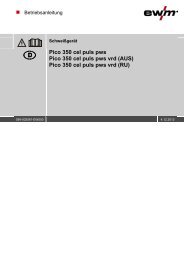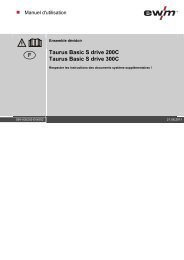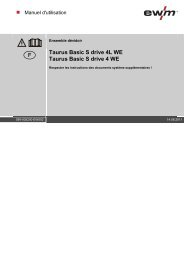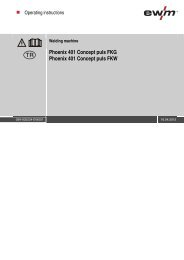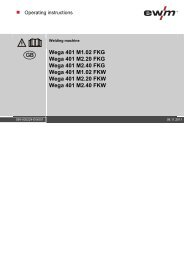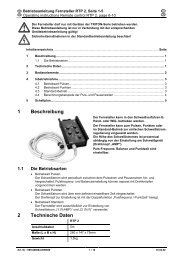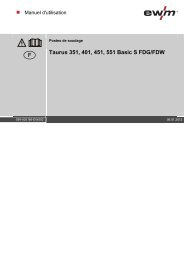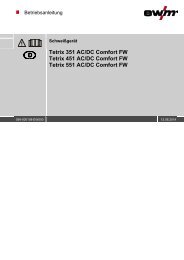Operating instructions - EWM Hightec Welding GmbH
Operating instructions - EWM Hightec Welding GmbH
Operating instructions - EWM Hightec Welding GmbH
Create successful ePaper yourself
Turn your PDF publications into a flip-book with our unique Google optimized e-Paper software.
Maintenance and testing<br />
Test<br />
7.3.6 Measuring the leakage current (protective conductor and contact current)<br />
Note: Even if the leakage current measurement according to the standard is only an alternative to the<br />
insulation resistance measurement, <strong>EWM</strong> recommends always performing both measurements,<br />
especially following repair work. The leakage current is based for the greater part on a physical effect<br />
other than the insulation resistance. For this reason, it may not be possible to uncover a dangerous<br />
leakage current using the insulation resistance measurement.<br />
These measurements cannot be performed with a normal multimeter. Even test devices for VDE 0702<br />
(especially older devices) are generally only intended for 50/60 Hz. With inverter welding machines,<br />
however, significantly higher frequencies occur, which can interfere with some measuring devices, and<br />
result in others measuring the frequency incorrectly.<br />
A test device must meet the requirements of VDE 0404-2. For the frequency response measurement,<br />
please refer to DIN EN 61010-1 Appendix A – Measuring circuit A1.<br />
NOTE<br />
For these measurements, the welding machine must be switched on and supplying open<br />
circuit voltage!<br />
1. Protective conductor current: < 5 mA<br />
2. Leakage current from the welding sockets separately to PE: < 10 mA<br />
7.3.7 Measurement of protective conductor resistance<br />
Measure between the plug earthed contact and accessible live parts, e.g. casing screws.<br />
During the measurement, the connection lead must be moved across the entire length, especially near<br />
the casing and plug inlet points. This should uncover any interruptions in the protective conductor. All<br />
conductive parts of the casing accessible from outside should also be tested to ensure a correct PE<br />
connection for safety class I.<br />
The resistance must not exceed a mains connection lead 0.3Ω up to 5m in length. For longer leads, the<br />
permissible value increases by 0.1Ω per 7.5m of lead. The maximum permissible value is 1Ω.<br />
7.3.8 Functional test of the welding machine<br />
Safety devices, selector switches and command units (if fitted) and the entire machine or the entire<br />
system for arc welding, must be functioning perfectly.<br />
1. Main switch<br />
2. Emergency stop devices<br />
3. Voltage reducing device<br />
4. Gas solenoid valve<br />
5. Message and control lamps<br />
7.3.9 Documentation of the test<br />
The test report must contain:<br />
• the designation of the tested welding equipment,<br />
• the date of the test,<br />
• the test results,<br />
• the signature, name of technician and the relevant institution,<br />
• the name of the test equipment.<br />
A label with the date of the test must be affixed to the welding machine to show that the test has been<br />
passed.<br />
Item No.: 099-000097-<strong>EWM</strong>01 69



